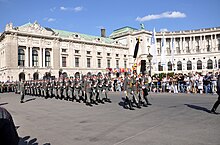Funeral procession
A funeral procession (outdated also funeral procession , rarely also funeral procession , occasionally also coffin procession or death procession ) is the procession of the mourners at a funeral , who walk behind the coffin with the corpse when it is driven or carried on its last way to the cemetery and grave , to bury him there; synonymously also referred to as the last escort .
It can be part of a funeral rite .
history
The tradition of the funeral procession goes back a long way, so there was already a festive funeral procession in the Roman Empire as pompa funebris , during which friends and relatives wore masks and robes of prominent ancestors of the deceased. The funeral procession was also a form of funeral service, which developed into a separate academic funeral at universities, among other places .
There are many different forms of funeral procession. So goes the Christian funeral ritual in a procession usually a candidate for confirmation , Kurrendaner or altar , which the processional cross bears the funeral ahead. The jazz funeral also includes a funeral procession. In Islamic funeral rites, only men are allowed to take part in funeral procession, women are forbidden, and believers are required to stand up when a funeral procession passes by. In the Buddhist burial culture in Vietnam , the funeral procession begins in the house of the dead, where they had previously been laid out for some time. In the past, this was also common for Christian burials in Germany, since the growth of cities and the corresponding greater distance between the cemetery and the apartment of the deceased or the hospital, morgues have mostly been common in cemeteries since the second half of the 19th century the deceased was laid out until burial. For hygienic reasons, this also prevailed in rural areas after the Second World War. Since then, the funeral procession has generally only led from the cemetery chapel or morgue to the grave.
Musically, funeral marches are usually based on a funeral procession: They are often held in a minor key, with a slow tempo and a steady rhythm . Funeral procession can also be accompanied by lamentations .
Conduct

A conduct is - especially in Austria - the solemn accompaniment of a coffin from the funeral hall to the grave in the form of a funeral procession. In terms of linguistic history, the name can be traced back to the Latin conductus “escort” or “protection”, to conducere “to merge”.
The coffin is covered with a towel (or a flag ) and the flower donations on the conduct . The coffin can be transported on a simple wagon, an electric cable car or a funeral carriage. The funeral procession is usually led by a clergyman . Behind it follows the coffin with the pallbearers (employees of the funeral home or relatives) and the mourners. The order in which the mourners follow the coffin depends on the degree of relationship to the deceased and the social position. At state funerals, a department of the federal army also takes part in the funeral procession in a conduct step.
Gustav Mahler described the 1st movement of his 5th symphony as a funeral march. In a measured step. Strict. Like a conduct .
gallery
Funeral procession in ancient Egypt
Depiction of a Mexican funeral procession
Funeral procession of Alexander the Great
Funeral procession at a Hindu funeral
Funeral procession of Elizabeth I of England
Beethoven's last escort
See also
literature
- Heike Karg: The funeral of Heinrich Posthumus Reuss 1636. A high point of the Protestant funus (= Kassel studies on sepulchral culture , vol. 17). Working group cemetery and memorial, Kassel 2010, ISBN 978-3-924447-46-5 .
Web links
Individual evidence
- ^ Anne-Sophie Fröhlich: Priestly tasks in Sunni Islam. Hamburg 1997, p. 46.
- ^ Corinna Kuhnen: Stranger Death. On the organization and institutionalization of Muslim, Jewish, Buddhist, Hindu and Yezidi burial rituals in Germany under the aspect of institutional problems and social integration. Dissertation University of Bremen 2009, p. 127.
- ↑ http://de.wiktionary.org/wiki/Kondukt
- ↑ Helmut Zilk's funeral .







